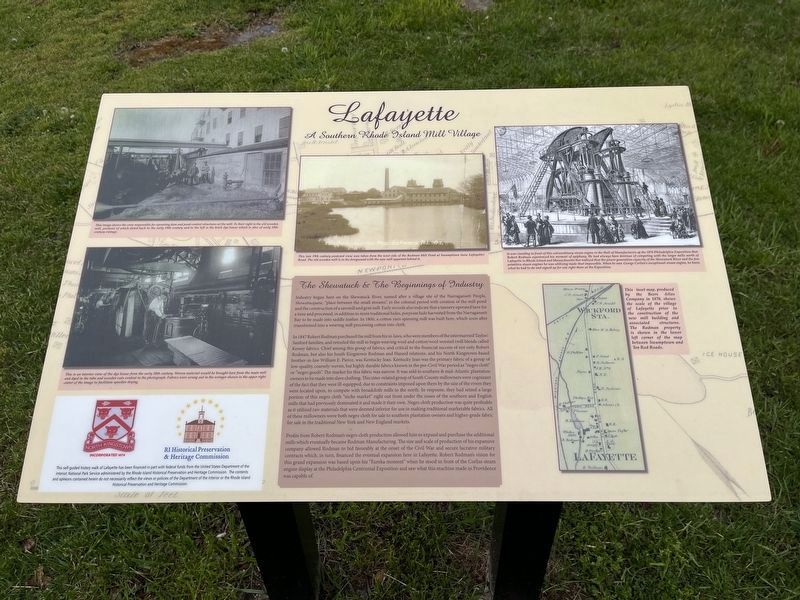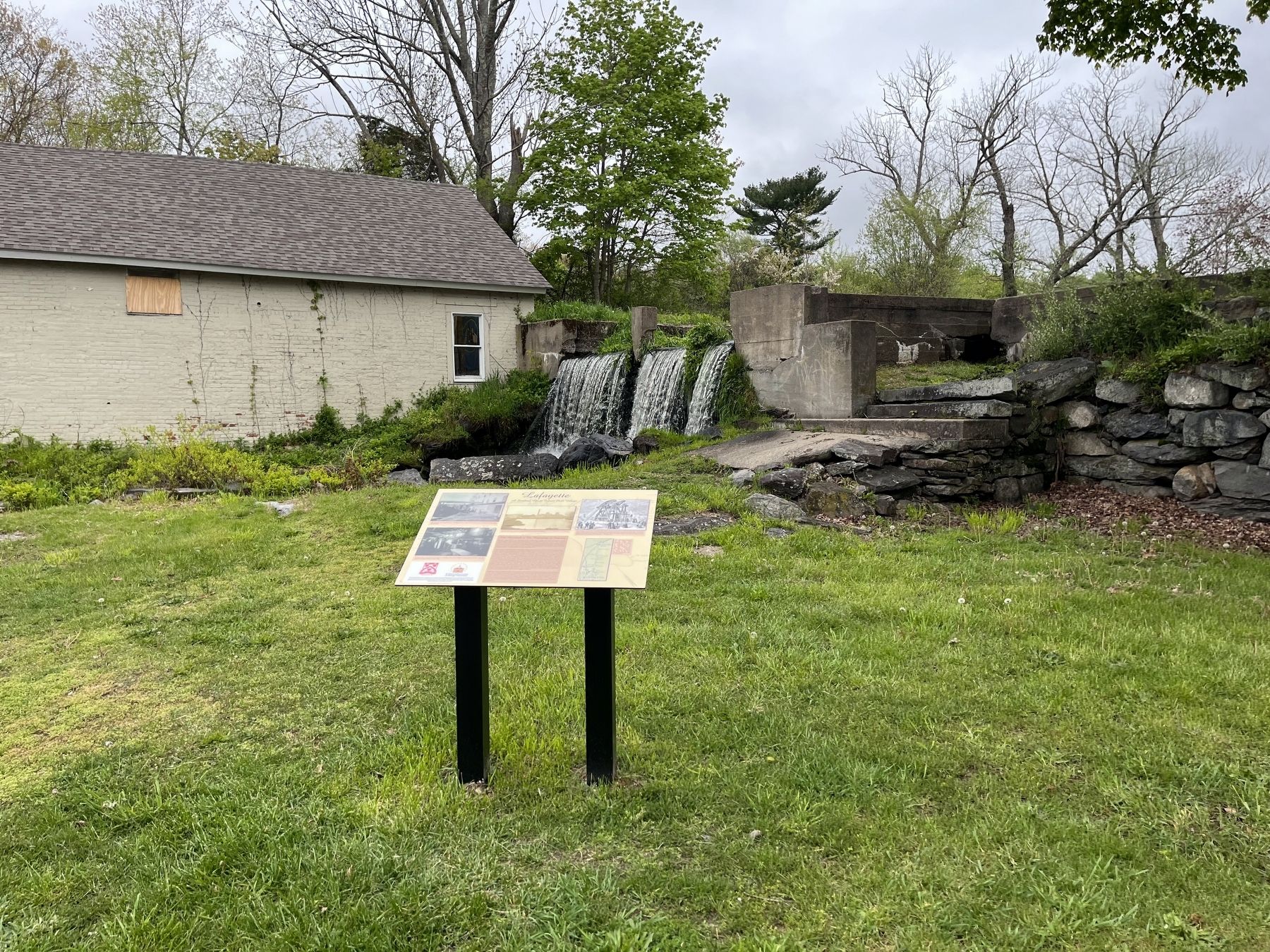Lafayette in North Kingstown in Washington County, Rhode Island — The American Northeast (New England)
The Shewatuck & The Beginnings of Industry
Lafayette
— A Southern Rhode Island Mill Village —

Photographed By Devry Becker Jones (CC0), May 5, 2023
1. The Shewatuck & The Beginnings of Industry Marker
Industry began here on the Shewatuck River, named after a village site of the Narragansett People, Showatucquese, "place between the small streams", in the colonial period with creation of the mill pond and the construction of a sawmill and grist mill. Early records also indicate that a tannery operated here for a time and processed, in addition to more traditional hides, porpoise hide harvested from the Narragansett Bay to be made into saddle leather. In 1800, a cotton yarn spinning mill was built here, which soon after transitioned into a weaving mill processing cotton into cloth.
In 1847 Robert Rodman purchased the mill from his in-laws, who were members of the intermarried Taylor/Sanford families, and retooled the mill to begin weaving wool and cotton/wool worsted twill blends called Kersey fabrics. Chief among this group of fabrics, and critical to the financial success of not only Robert Rodman, but also his South Kingstown Rodman and Hazard relations, and his North Kingstown-based brother-in-law William E. Pierce, was Kentucky jean. Kentucky Jean was the primary fabric of a group of low-quality, coarsely-woven, but highly durable fabrics known in the pre-Civil War period as "negro cloth" or "negro goods". The market for this fabric was narrow. IT was sold to southern & mid-Atlantic plantation owners to be made into slave clothing. This inter-related group of South County millowners were cognizant of the fact that they were ill-equipped, due to constraints imposed upon them by the size of the rivers they were located upon, to complete with broadcloth mills to the north. In response, they had seized a large portion of this negro cloth "niche market" right out from under the noses of the southern and English mills that had previously dominated it and made it their own. Negro cloth production was quite profitable as it utilized raw materials that were deemed inferior for use in making traditional marketable fabrics. All of these millowners wove both negro cloth for sale to southern plantation owners and higher-grade fabric for sale in the traditional New York and New England markets.
Profits from Robert Rodbman's negro cloth production allowed him to expand and purchase the additional mills which eventually became Rodman Manufacturing. the size and scale of production of his expansive company allowed Rodman to bid favorably at the onset of the Civil War and secure lucrative military contract which, in turn, financed the eventual expansion here in Lafayette. Robert Rodman's vision for this grand expansion was based upon his "Eureka moment" when he stood in front of the Corliss steam engine display at the Philadelphia Centennial Exposition and saw what this machine made in
[Captions:]
This image shows the crew responsible for operating dam and pond control structures at the mill. To their right is the old wooden mill, portions of which dated back to the early 19th century and to the left is the brick dye house which is also of early 19th century vintage.
This is an interior view of the dye house from the early 20th century. Woven material would be brought here from the main mill and dyed in the tubs and wooden vats evident in the photograph. Fabrics were wrung out in the wringer shown in the upper right center of the image to facilitate speedier drying.
This late 19th century postcard view was taken from the west side of the Rodman Mill Pond at Swamptown (now Lafayette) Road. The old wooden mill is in the foreground with the new mill apparent behind it.
It was standing in front of this extraordinary steam engine in the Hall of Manufacturers at the 1876 Philadelphia Exposition that Robert Rodman experienced his moment of epiphany. He had always been desirous of competing with the larger mills north of Lafayette in Rhode Island and Massachusetts but realized that the power generation capacity of the Shewatuck River and the few primitive steam engines he was utilizing made that impossible. When he saw George Corliss's exceptional steam engine, he knew what he had to do and signed up for one right there at the Exposition.
This inset map, produced by the Beers Atlas Company in 1870, shows the scale of the village of Lafayette prior to the construction of the new mill building and associated structures. The Rodman property is shown in the lower left corner of the map between Swamptown and Ten Rod Roads.
Erected by Town of North Kingstown; RI Historical Preservation & Heritage Commission.
Topics. This historical marker is listed in these topic lists: Industry & Commerce • Native Americans • Settlements & Settlers • Waterways & Vessels. A significant historical year for this entry is 1800.
Location. 41° 34.382′ N, 71° 29.182′ W. Marker is in North Kingstown, Rhode Island, in Washington County. It is in Lafayette. Marker is at the intersection of Ten Rod Road (Rhode Island Route 102) and Advent Street, on the right when traveling east on Ten Rod Road. Touch for map. Marker is at or near this postal address: 650 Ten Rod Rd, North Kingstown RI 02852, United States of America. Touch for directions.
Other nearby markers. At least 8 other markers are within 2 miles of this marker, measured as the crow flies. A Millworker's Life (within shouting distance of this marker); The New Mill & New Beginnings (about 300 feet away, measured in a direct line); Centerpiece of the Rodman Empire (about 300 feet away); Robert Rodman's Village (about 400 feet away); The Rail Connection (about 500 feet away); Hortense Rodman Allen House (approx. ¼ mile away); Roger Williams (approx. 1½ miles away); North Kingstown G.A.R. Monument (approx. 1.9 miles away). Touch for a list and map of all markers in North Kingstown.
Credits. This page was last revised on May 8, 2023. It was originally submitted on May 8, 2023, by Devry Becker Jones of Washington, District of Columbia. This page has been viewed 58 times since then and 8 times this year. Photos: 1, 2. submitted on May 8, 2023, by Devry Becker Jones of Washington, District of Columbia.
